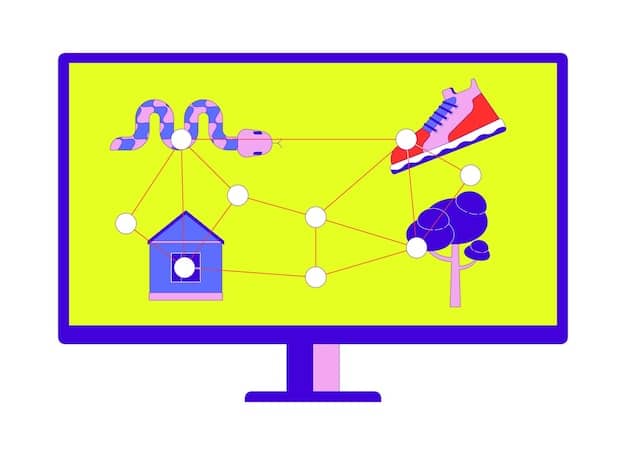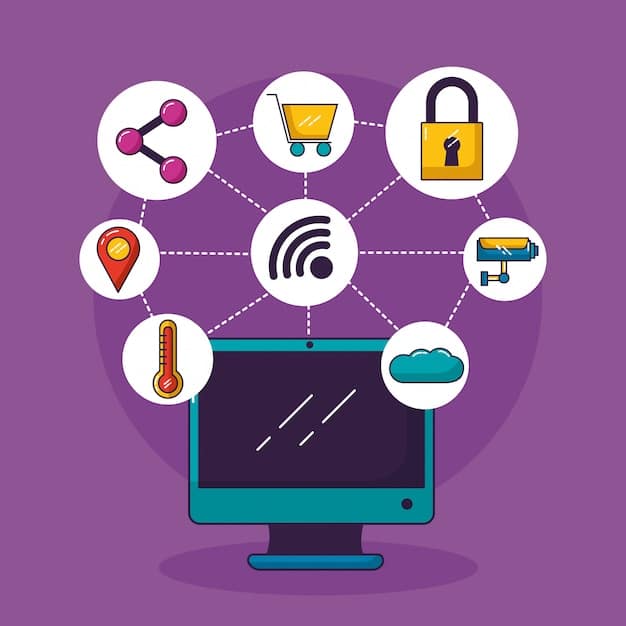Cybersecurity Alert: Unsecured IoT Devices Threaten US Homes

Cybersecurity Alert: Unsecured IoT Devices Pose a Major Risk to US Home Networks, turning everyday conveniences into potential entry points for cyber threats, demanding vigilant security measures.
A growing concern for US homeowners is the increasing vulnerability of their home networks due to unsecured IoT devices. This Cybersecurity Alert: Unsecured IoT Devices Pose a Major Risk to US Home Networks and demands immediate attention.
Understanding the IoT Threat Landscape in US Homes
The Internet of Things (IoT) has revolutionized how we live, connecting various devices to our home networks. However, this convenience comes with inherent risks, as many of these devices lack adequate security measures. Understanding the specific threats posed by these devices is crucial for maintaining a secure home network.
Commonly Unsecured IoT Devices
Many IoT devices are designed with functionality as the primary focus, often neglecting security considerations. It’s important to identify these vulnerable devices to take appropriate countermeasures.
- Smart TVs: Often collect viewing data and can be vulnerable to hacking.
- Smart Speakers: Can be exploited to eavesdrop or control other smart devices.
- Security Cameras: If not properly secured, they can be accessed remotely by unauthorized users.
- Smart Thermostats: Can be manipulated to disrupt home comfort or gain access to the network.
These devices, when unsecured, act as entry points for cybercriminals, allowing them to compromise the entire home network.

The Impact of a Compromised IoT Device
A single unsecured IoT device can have far-reaching consequences, affecting not just the device itself but the entire home network and its connected devices.
- Data Breach: Personal information stored on or accessed through IoT devices can be stolen.
- Identity Theft: Cybercriminals can gather enough data to impersonate users for financial gain.
- Network Hijacking: A compromised device can be used as a gateway to access and control the entire home network.
- Privacy Violation: Hackers can access camera feeds, microphone recordings, and other sensitive data.
The potential for harm is significant, underscoring the need for robust security measures to protect IoT devices and home networks.
In conclusion, the pervasiveness of unsecured IoT devices presents a significant cybersecurity challenge for US homeowners. By understanding the threat landscape and the potential impact of compromised devices, homeowners can take proactive steps to secure their networks and protect their personal information.
Assessing the Security Risks of Your Home Network
Before implementing security measures, it’s essential to assess the current state of your home network. This involves identifying potential vulnerabilities and understanding the specific risks associated with each IoT device connected to your network.
Conducting a Home Network Audit
A comprehensive network audit can help identify weak points and potential entry points for cyber threats. Here are some essential steps to follow:
- Inventory of Devices: Create a list of all devices connected to your home network, including make, model, and IP address.
- Firmware Updates: Check for available firmware updates for each device. Outdated firmware often contains known security vulnerabilities.
- Default Passwords: Change default passwords on all devices. These are often publicly known and easy to exploit.
- Network Segmentation: Consider segmenting your network to isolate sensitive devices from less secure ones.
By conducting a thorough audit, you can gain a clear understanding of your network’s security posture and identify areas that require immediate attention.
Identifying Vulnerable IoT Devices
Certain characteristics can indicate whether an IoT device is more vulnerable than others. Being aware of these signs is crucial for prioritizing security efforts.
- End-of-Life Devices: Devices no longer supported by the manufacturer are unlikely to receive security updates.
- Lack of Security Features: Devices without password protection or encryption are inherently vulnerable.
- Unknown Manufacturers: Devices from lesser-known brands may not adhere to security best practices.
- Cloud Dependency: Devices that rely heavily on cloud services can be compromised if the cloud service is breached.
Identifying these vulnerable devices allows you to take targeted security measures to mitigate the risks they pose.
In summary, assessing the security risks of your home network involves conducting a thorough audit and identifying vulnerable IoT devices. This proactive approach enables homeowners to take appropriate measures to safeguard their networks and protect against potential cyber threats.
Securing Your IoT Devices: Practical Steps
Once you’ve assessed the security risks of your home network, the next step is to implement practical security measures to protect your IoT devices. These measures can range from simple configuration changes to more advanced network security implementations.

Essential Security Measures
These steps cover the basics of securing your IoT devices and should be implemented as a first line of defense.
Change Default Passwords
Always change the default passwords on your IoT devices to strong, unique passwords. Use a password manager to generate and store complex passwords.
Enable Two-Factor Authentication (2FA)
If available, enable 2FA for your IoT devices. This adds an extra layer of security by requiring a second verification method, such as a code sent to your phone.
Advanced Security Strategies
For more robust protection, consider implementing these advanced strategies to secure your home network.
Network Segmentation
Segment your home network to isolate IoT devices from more sensitive devices, such as computers and smartphones. This can be achieved using a router that supports VLANs (Virtual LANs).
Firewall Configuration
Configure your firewall to restrict incoming and outgoing traffic to only what is necessary for your IoT devices to function. This can help prevent unauthorized access.
In conclusion, securing your IoT devices requires a combination of essential security measures and advanced strategies. By implementing these steps, homeowners can significantly reduce the risk of cyberattacks and protect their home networks.
Staying Updated: Firmware and Software Management
Keeping your IoT devices’ firmware and software up-to-date is crucial for maintaining a secure home network. Updates often include security patches that address known vulnerabilities and protect against emerging threats. Neglecting these updates can leave your devices exposed to cyberattacks.
- Regularly checking for updates
- Automating updates where possible
- Ensuring compatibility before updating
Failing to maintain your firmware and software puts your devices at risk.
The Importance of Timely Updates
Timely updates provide security patches that address known vulnerabilities, protect against new threats, and ensure optimal device performance. Ignoring updates can leave your devices exposed to cyberattacks.
Security Patches
Security patches fix vulnerabilities discovered by security researchers and manufacturers. Applying these patches promptly is essential for preventing exploitation by cybercriminals.
Performance Improvements
Updates also include performance improvements that enhance device functionality and stability. These improvements can extend the lifespan of your devices and improve their overall performance.
Keeping your firmware and software up-to-date is a critical security practice. By prioritizing timely updates, you can protect your IoT devices and home network from potential cyber threats.
Monitoring and Detection: Vigilance is Key
Even with robust security measures in place, it’s essential to continuously monitor your home network for suspicious activity. Early detection of potential threats can prevent significant damage and minimize the impact of cyberattacks. Implementing effective monitoring and detection strategies is crucial for maintaining a secure home network.
Tools for Network Monitoring
Various tools are available to help monitor your home network for suspicious activity. These tools can provide insights into network traffic, device behavior, and potential security breaches.
- Intrusion Detection Systems (IDS): These systems monitor network traffic for malicious activity and alert you to potential threats.
- Network Analyzers: These tools capture and analyze network traffic to identify anomalies and suspicious patterns.
- Security Information and Event Management (SIEM) Systems: These systems collect and correlate security logs from various devices and applications to provide a comprehensive view of your network’s security posture.
By utilizing these tools, you can gain better visibility into your home network and detect potential threats early on.
Recognizing Suspicious Activity
Knowing what to look for is essential for detecting suspicious activity on your home network. Here are some common signs of a potential cyberattack:
- Unusual Network Traffic: A sudden increase in network traffic or traffic to unfamiliar destinations can indicate a compromised device.
- Unauthorized Access: Login attempts from unknown locations or devices can signal a potential breach.
- Device Malfunctions: Unexpected device behavior, such as crashing or freezing, can be a sign of malware infection.
- Data Exfiltration: Large amounts of data being transferred out of your network can indicate data theft.
By being vigilant and recognizing these signs, you can quickly respond to potential threats and minimize their impact on your home network.
In summary, monitoring and detection are critical components of a comprehensive cybersecurity strategy for US homes. By implementing network monitoring tools and recognizing suspicious activity, homeowners can proactively protect their networks from potential cyber threats.
Educating Your Family: A Human Firewall
While technical security measures are essential, it’s equally important to educate your family members about cybersecurity best practices. Human error is a leading cause of security breaches, so creating a “human firewall” can significantly enhance your home network’s security.
Teaching Basic Cybersecurity Practices
Educate your family members about the importance of strong passwords, phishing awareness, and safe browsing habits. Simple practices that significantly reduce the risk of falling victim to cyberattacks.
- Password Security: Emphasize the importance of using strong, unique passwords and avoiding password reuse.
- Phishing Awareness: Teach family members how to identify and avoid phishing emails and scams.
- Safe Browsing: Encourage family members to avoid suspicious websites and downloads.
By instilling these basic cybersecurity practices, you can significantly reduce the risk of human error leading to a security breach.
Creating a Security-Aware Culture
Promote a culture of security awareness within your household by discussing potential threats and encouraging family members to report suspicious activity. Open communication can help identify and address security concerns before they escalate.
- Regular Discussions: Hold regular discussions about cybersecurity threats and best practices.
- Reporting Suspicious Activity: Encourage family members to report any suspicious activity they encounter online.
- Leading by Example: Demonstrate good cybersecurity habits yourself to set a positive example for your family.
In summary, educating your family is just as important as installing technical security measures. Promoting security awareness and establishing open communication reduces risk.
| Key Point | Brief Description |
|---|---|
| 🔑 Change Default Passwords | Always change default passwords to secure, unique ones. |
| 🛡️ Enable 2FA | Add an extra security layer with Two-Factor Authentication. |
| 🚨 Monitor Network Activity | Use tools to detect and respond to suspicious network activity. |
| 🔄 Keep Devices Updated | Regularly update firmware and software to patch vulnerabilities. |
Frequently Asked Questions (FAQ)
▼
IoT devices are physical objects embedded with sensors, software, and other technologies for the purpose of connecting and exchanging data with other devices and systems over the internet. Examples include smart TVs, security cameras, and smart thermostats.
▼
Unsecured IoT devices often lack basic security measures, like strong passwords or encryption, making them vulnerable to hacking. Cybercriminals can exploit these vulnerabilities to gain access to your home network and steal personal data.
▼
To secure your IoT devices, change default passwords, enable two-factor authentication, keep firmware updated, segment your network, and monitor for suspicious activity. Educating your family about cybersecurity is also essential.
▼
Network segmentation divides your home network into separate subnetworks, isolating IoT devices from more sensitive devices like computers. This prevents a compromised IoT device from providing access to your entire network.
▼
Monitor your network traffic for unusual activity, login attempts from unknown locations, and unexpected device malfunctions. Security Information and Event Management (SIEM) systems can help detect these anomalies.
Conclusion
In conclusion, securing your home network against the risks posed by unsecured IoT devices requires a multifaceted approach. By understanding the threats, assessing vulnerabilities, implementing security measures, staying updated, monitoring your network, and educating your family, you can significantly reduce your risk and protect your digital life.





